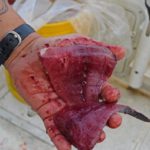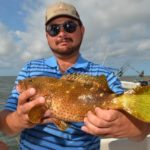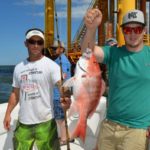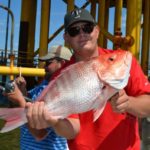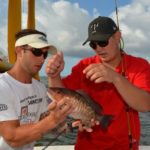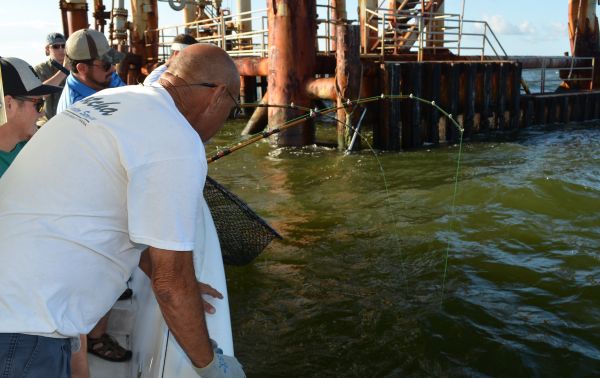
You never know what’s going to bite when you lower a bait offshore, but that’s what keeps this captain going back for more. Learn how he targets red and mangrove snapper while he enjoys the lagniappe of the Gulf.
The deeply tanned, athletically-built 65-year-old man was standing in the shade beneath Bridgeside Marina on Grand Isle. He was responding to a question about offshore charter guiding.
“I love it. It’s like opening a box of chocolates: You never know what you are going to bite into at each different platform,” he said. “We have the best fishing in the world because of those oil and gas platforms. Grand Isle has everything right here: specks and reds inshore and unlimited species offshore.”
By his own admission, Gotcha Fishing Charters owner Bobby Terrebonne (985-870-2141) is a “bottom fishing specialist,” although he will troll if he hits a rip line.
His targets are pretty simple.
“I go after red snapper when the season is open. When it isn’t, I chase mangrove snappers,” Terrebonne said. “I like amberjacks when the season is open, and I used to love catching triggerfish. They are one of the best-eating fish.”
He rolls his eyes for emphasis. He was clearly unhappy with new regulations that not only provide a June-July closed season, but a two gray triggerfish per person bag limit.
Terrebonne admited to having a soft spot for taking youngsters out on charters.
“When we have one on the boat and we catch a shark, they get so excited,” he said. “They want you to put it in the boat so that they can play with it.”
He also claims to enjoy taking people out who have never fished before, which is a good thing. As a charter captain, he gets them.
Last red snapper season, he guided four young men — Michael Davis, Chad Engle (the groom), Jon Mitchell and Tyler Reese, half of a bachelor party coming out of Van Horn, in far west Texas. Two of them, Davis and Reese, were horse-riding cowboys.
None of them had ever been in the Gulf before.
At their first stop, West Delta Block 94, in 159 feet of water, the four young men stood, mouths gaping and wide-eyed.
Davis spoke first.
“Wow. All we see in West Texas is dirt,” he said. “It’s on the ground, it’s in the air, it’s in your teeth, it’s in your hair; its everywhere.”
With this crew, Terrebonne and deck hand Dex Legendre had to start from scratch, which is not necessarily a bad thing because they didn’t have to get the Texans to unlearn bad fishing habits.
Legendre assembled the group and began coaching them about bottom fishing techniques.
Don’t set the hook when you get a bite, he told them. Circle hooks, which are required to be used for snapper fishing by law, hook the fish by themselves. Jerking hooks simply pulls them out of their mouths.
He went on: Keep a tight line when reeling in fish. Pausing during reeling will let fish get off the hook. Keep the rod tip up to put pressure on the fish. Pump the fish up with the rod, and then reel in the line gained while lowering the rod tip for another pump.
The youthful deck hand explained that the captain will know at what depth the snappers are holding by watching his depth sounder, and then he demonstrated the methods to calculate how their bait is lowered to the correct water depth.
It was a lot for them to take in all at once, but they seemed game.
Down went the baits. Bites started almost immediately. Several legal-sized red snappers came up, which Terrebonne promptly vented and released, to the astonishment of the young men who had probably just caught the biggest fish of their lives.
“They’re not big enough,” Terrebonne explained with a mischievous grin, “They are not what we are looking for.”
Soon, one of those “box of chocolates” fish came up on Davis’s line — a rock hind, a highly colorful member of the grouper family.
The fish were willing, but the flesh was weak. By 8:30 a.m., three of the four men had developed a green pallor and had wilted, resting their rods on the boat gunnels.
First one than another went to the rail, retching. To their credit, none of them quit fishing — but they looked terrible.
Since a boat that’s tied off always bobs worse than one running and Terrebonne wanted to find more and bigger red snapper anyway, he cast off the platform and ran to another site — twin platforms at West Delta 95.
The temporarily resuscitated men rapidly drooped again after the boat was hooked to the platform. Legendre tried distracting them with talk about where to party and eat while they were in Louisiana.
Terrebonne went up front and teased and challenged them.
Nothing seemed to help.
Then the boat shifted. A different body of water moved under the moored boat and it swung 90 degrees from where it was. The bobbing immediately subsided, aided by declining seas from a slackening in wind speed.
The men immediately perked up and began to fish harder. They ravenously attacked Terrebonne’s home-made French bread sandwiches and soft drinks.
From the shade of his T-top, Terrebonne noted the change with satisfaction.
“It’s not only about catching fish,” he said. “It’s about camaraderie and cutting up. I want to see customers enjoying themselves.”
The young men were.
It seemed like a couple of them always had cell phones out taking pictures of each other posing with fish. Every different species produced a round of picture-taking: a scamp, a jack crevalle, a lookdown, a big bluefish, a redfish and the highlight of the day — a solid, 6-foot-long blacktip shark.
The predator slugged it out all the way up, and then put on a smashing performance at the surface, as if it knew it had an audience. Before Legendre could cut the leader, the animal left seawater dripping from the bills of three baseball caps (Mitchell had his on backwards).
The Texans were as tickled as little kids about tangling with a man-eater.
By mid-morning, the men had limited out on red snappers, and Terrebonne took them into shallower waters to target mangroves — a much more difficult quarry.
After the boat was hooked up to a corner of a platform, deck hand Legendre stood in the bow and tossed bits of pogies that he tore up with his hands near the platform’s legs.
He positioned a fisherman on his left and on his right. Each was equipped with a spinning rod baited with a live croaker. When mangrove snappers ventured out from the protection of the platform, the fishermen were to flip-cast their hook-bearing croakers to the fish.
Next came the tricky part.
Immediately after a fish was hooked, the angler was to move quickly toward the rear of the boat, physically dragging the fish away from the line-cutting barnacles covering the platform legs.
Most of the time, in the excitement of seeing a fish come out and smash their hooks, the men would forget to move, instead standing still and furiously cranking the reel handle.
The result was almost always the same: The fish dove its nose into the barnacles and the line was cut.
Over and over, Terrebonne and Legendre good-naturedly tied on new hooks and sent the young men back into battle.
Fifty hooks later, the score was Texans 1, mangrove snappers 49.
But they (both the snappers and the Texans) had fun.
“This offshore fishing is way better than onshore fishing,” Mitchell exclaimed. “The fish are way bigger and they fight harder.”
Davis agreed.
“They sure are pretty fish too,” he said. “A lot prettier than what we have — catfish in the Rio Grande River.
“If you can find any water in it.”


